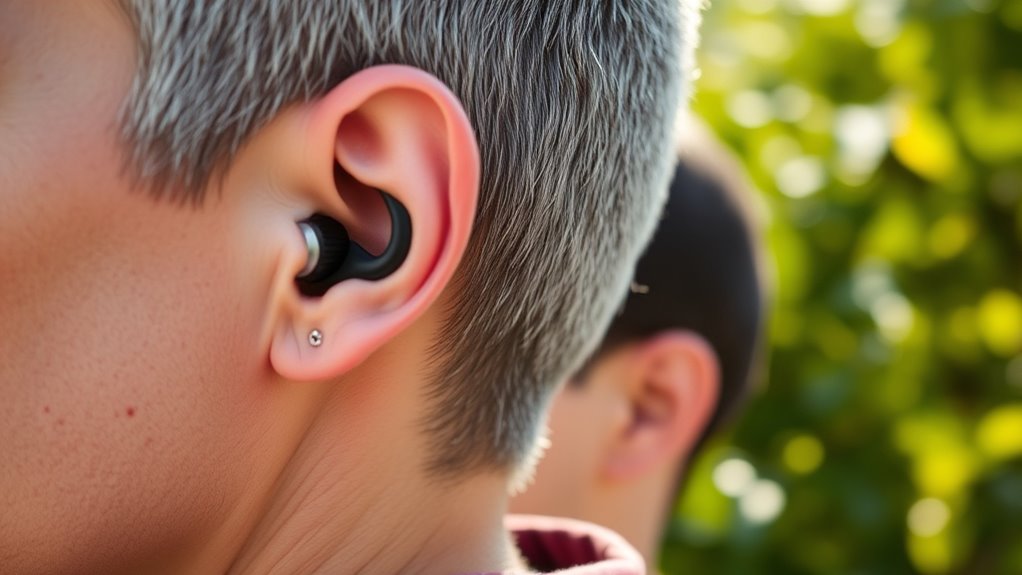Bimodal hearing involves coordinating your cochlear implant and hearing aid to work together seamlessly. This coordination enhances sound quality, speech understanding, and overall hearing comfort. Modern systems use wireless technology and synchronized programming to align device outputs and processing strategies. Regular check-ups guarantee your devices stay properly tuned, adapting to your changing needs. If you’re interested, you’ll discover more about how these advancements make your listening experience richer and more natural.
Key Takeaways
- Integrate programming of both CI and HA to ensure complementary and balanced sound output.
- Synchronize processing strategies and timing for seamless auditory signals across devices.
- Utilize wireless connectivity features for dynamic, automatic adjustments in various listening environments.
- Regularly consult audiologists to optimize device settings and maintain effective coordination.
- Focus on achieving natural sound quality and reducing cognitive effort through proper device calibration.

Bimodal hearing combines the use of a cochlear implant in one ear with a hearing aid in the other, offering a versatile solution for those with asymmetric hearing loss. When you choose this approach, your goal is to seamlessly blend the benefits of both devices to improve your overall hearing experience. Achieving this requires careful cochlear implant integration and effective hearing aid synchronization. These processes ensure that your devices work together smoothly, providing natural sound quality and better speech understanding.
Bimodal hearing combines cochlear implants and hearing aids for a seamless, natural listening experience.
Cochlear implant integration involves programming both your cochlear implant and hearing aid so they complement each other. This means calibrating each device to ensure their outputs align, reducing any conflicting signals or echoes. Your audiologist might adjust the settings so that the sounds from both devices are balanced, which helps your brain process sounds more naturally. Proper cochlear implant integration minimizes the disconnect you might feel when switching between devices or trying to follow conversations in noisy environments. It’s about creating a cohesive auditory experience, where the brain perceives sounds as coming from a single, unified source.
Hearing aid synchronization is equally important. It involves coordinating the processing strategies and timing of your hearing aid and cochlear implant to work in harmony. For example, some hearing aids can be programmed to detect the signals sent to your cochlear implant, allowing them to adjust amplification levels accordingly. This synchronization helps your brain interpret sounds more accurately, especially in complex environments like bustling restaurants or crowded streets. When your devices are synchronized properly, you experience a smoother transition between them, reducing the cognitive effort needed to understand speech or identify sounds.
Many modern systems offer wireless connectivity features that facilitate hearing aid synchronization with cochlear implants. These technologies enable your devices to communicate seamlessly, dynamically adjusting to changing acoustic environments. By leveraging these advancements, you can enjoy a more natural listening experience without constantly adjusting volume or settings manually.
Ultimately, successful bimodal hearing depends on consistent communication between your cochlear implant and hearing aid. Regular check-ups with your audiologist ensure that both devices remain properly synchronized, adapting to your changing hearing needs. When cochlear implant integration and hearing aid synchronization are optimized, you gain a richer, more balanced soundscape. This setup not only enhances your ability to perceive speech but also improves your overall quality of life by making sounds feel more natural and easier to interpret.
Frequently Asked Questions
How Does Bimodal Hearing Impact Speech Understanding in Noisy Environments?
In noisy environments, speech understanding can be challenging, but bimodal hearing helps improve it. You benefit from enhanced noise reduction, as the hearing aid and cochlear implant work together to filter out background sounds. This coordination boosts speech clarity, making it easier to follow conversations. Bimodal hearing leverages the strengths of both devices, providing a more natural listening experience and better communication in complex acoustic settings.
Can Bimodal Hearing Improve Music Appreciation?
Bimodal hearing can enhance your music enjoyment and tonal perception by combining the strengths of cochlear implants and hearing aids. This coordination allows you to better perceive pitch and melodies, which are often challenging with a single device. As a result, you experience richer sound quality and more natural music, making listening more immersive and enjoyable. Bimodal setups help you reconnect with music on a deeper level, improving overall auditory satisfaction.
What Are the Potential Challenges of Coordinating CIS and Hearing Aids?
Imagine juggling flames without getting burned—that’s what coordinating CIS and hearing aids can feel like. Device compatibility is a key challenge, as not all devices sync seamlessly, leading to potential sound mismatches. User training is essential to navigate these nuances confidently. Without proper guidance, you might find yourself overwhelmed, like trying to tame a wild stallion. Clear instructions and compatible tech help make sure you keep the performance smooth and harmonious.
How Does Bimodal Hearing Affect Sound Localization Abilities?
Bimodal hearing improves your sound localization by enhancing your ability to identify the sound source. When you use both cochlear implants and hearing aids, you gain better spatial awareness because each device provides unique auditory cues. This combined input helps your brain interpret the location of sounds more accurately, giving you a clearer sense of where noises come from and improving overall environmental awareness.
Are There Specific Hearing Aid Features Beneficial for Bimodal Users?
You’ll find that hearing aid features like hearing aid compatibility and adaptive noise reduction greatly benefit your bimodal setup. These features help you hear more clearly by reducing background noise and guaranteeing your hearing aids work seamlessly with your cochlear implant system. Compatibility ensures smooth integration, while adaptive noise reduction enhances speech understanding in noisy environments, making your overall listening experience more natural and less tiring.
Conclusion
By combining cochlear implants with hearing aids, you can markedly improve your hearing experience. Studies show that bimodal users often enjoy better speech understanding and sound quality. For instance, about 60% of bimodal users report enhanced communication in noisy environments compared to using a cochlear implant alone. Embracing this coordinated approach could transform your hearing, helping you stay connected and engaged with the world around you. Don’t miss out on the full potential of your hearing capabilities.











